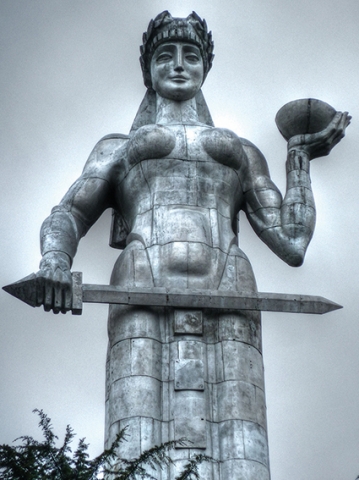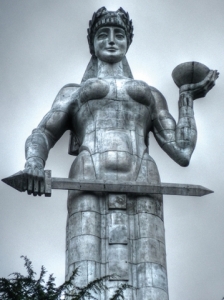Stability And Instability In Georgia
The Georgia Analysis is a twice monthly analysis of political and other major developments in Georgia. Lincoln Mitchell is a political development, research and strategic consultant who has worked extensively in the post-Soviet space. He has agreed to share some of his analyses with GEORGIA TODAY.
Since once again achieving its independence in 1991, the Georgian State has faced innumerable challenges and obstacles. One of the most significant of these was that Georgia found itself in a rough neighborhood. The conflict between Azerbaijan and Armenia in the early 1990s, the proximity to Iraq in the following decade, to the tumultuous Middle East in general in recent years, as well as to conflict-wrought parts of Russia, such as Chechnya, all made the project of state and democracy building in Georgia even more difficult. Additionally, the Russian actions, most notably in Abkhazia and South Ossetia, but in Georgia more broadly as well, have only made life more arduous for Georgia.
Georgia’s immediate neighborhood remains riven with tumult and conflict. The Middle East is becoming more unstable with refugee crises and violence from that region having an increasingly global impact. Armenia and Azerbaijan are still frequently on the cusp of renewed conflict and the recent coup attempt in Turkey raised the specter of instability in a large neighboring country that is a member of NATO and has been an important trade partner and ally of independent Georgia.
Interestingly, as Georgia’s region experiences even greater instability than in recent years, Georgia itself is slowly, and relative to only a few years ago, implausibly, emerging as something of an island of stability. While Georgia is certainly still characterized by contentious and polarizing politics, significant economic challenges and a Russian presence in Abkhazia and South Ossetia, the State itself is more stable than at any time in recent memory, particularly when compared to the rest of the region. Today, Georgia looks more stable than much of the Middle East, Turkey, Ukraine or either of its South Caucasus neighbors. This is seen in the general tone of political life, the often overlooked continuity on key policies between this government and the previous one and even in electoral politics shortly before parliamentary elections.
The coming elections in the autumn are expected to be very competitive. It is very likely that three or more parties will exceed the five percent threshold for their party list to get into parliament, and possible that no party will win a clear majority of seats in the new parliament, making it necessary to form a coalition government. Of course, four years ago the governing party lost the parliamentary election, but four summers ago very few, other than Georgian Dream (GD) activists, thought that was possible. The defeat of the governing United National Movement (UNM) in 2012 was as much a regime collapse as a peaceful transition.
The election this year, regardless of who wins, will not be a case of regime collapse or even regime change. This is evident by the encouraging reality that while rhetoric on both sides is strong, and will get stronger as the election approaches, the central dynamic of this election is not one of an opposition demanding regime change and a government presenting themselves as essential to the country’s future security and even survival. The recent six party declaration affirming Georgia’s commitment to NATO is further evidence of this.
There are no guarantees that Georgia can maintain this stability. That is the nature of political stability in any country. It can seem permanent and strong one moment and dissolve relatively quickly the next. Moreover the path to meaningful enduring stability is a difficult one; and Georgia still has some distance to go to achieve that. An election that runs smoothly and ends peacefully in which the governing party may remain in power, but loses some seats, will help institutionalize this stability.
Stability, however, is about more than just elections. Institutions must be strengthened, but there also needs to be a popular consensus around the nature of the Georgian State. This consensus is emerging, but it is not quite present yet. While the idea of democracy as the way to organize the Georgian State seems strong, fissures around the relationship between the State and Church, the struggle to fully incorporate ethnic minorities into the modern Georgian State, external pressure from Russia, the role of unelected leaders and ongoing economic pressure are all factors potentially working against the further institutionalization of stability.
The sense of stability in Georgia is also partially a product of the GD’s style of governance. One of the most frequently heard criticisms of the GD government, particularly from those who are not strong UNM or GD supporters, is that the GD either has not done enough or is not working actively enough to solve Georgia’s problems. This assertion may or may not have some credence, but the contrast between the GD and the UNM in this respect is hard to miss. The UNM style of governance by adrenaline certainly brought great energy to bear on Georgia’s problems, and helped make possible the wave of reforms during the two or three years immediately following the Rose Revolution, but it was also a handmaiden to the low to mid-level crises of stability that characterized the last half of the decade or so the UNM were in power.
As Georgia has become more stable it will continue to become more important to the West. Georgia has struggled to remain a top priority for the US and Europe since independence. Initially, this relevance rested largely on the figure of Eduard Shevardnadze. In the Rose Revolution period, Georgia sought to make itself relevant by being, in George W. Bush’s words a “beacon of democracy,” but once that was no longer plausible, it sought to position itself as an anti-Russian bulwark and libertarian paradise, but both of those concepts had somewhat limited ideological relevance. Today, Georgia, whether the leaders recognize it or not, is arguing that stability is what makes it important and relevant. Georgia can only be an ally in the struggle against an aggressive Russia to its north, or against the wellsprings of Islamic terror to its south, if it is stable. Demonstrating this is no small part of the reason that Georgia continues to make steady, if slow, progress towards NATO and the EU.
Stability is both real and perception based. Therefore, it is important for Georgia to be both stable and perceived as stable. Moreover, as a given country becomes more broadly seen as stable, international actors behave in a way that helps that country become more stable, for example, by investing more, bringing Georgia even closer to NATO and the EU, and even sending more tourists here. However, to become more stable, and prompt this kind of behavior from western countries, Georgia must continue to present itself to the world as more stable. Elections that are not presented or seen as an existential referendum on the country’s future, less talk of eminent Russian invasion, even as the threat from Russia remains real, and a politics that does not vilify opponents or make unrealistic promises are all ways Georgia can make itself seen as more stable.
The current government has made steps in all these directions, but there is a good deal of work still to do, and not simply by the government. Election related violence of the kind in Kortskheli a few months ago endangers Georgia’s democratic evolution, but also sends the world a message that Georgia is less than stable. The frequent comments from the Governor of Odessa that he will return to Georgia in the near future is not exactly a harbinger of calm either. A definitive end to political reprisals, the continued reduction of the role of unelected individuals in the country’s governance and fewer cabinet shakeups would also contribute to greater stability here.
Stability, in Georgia, or anywhere else, is both difficult to predict and identify and also frustratingly transient. The space between stability for the foreseeable future and instability that is viewed as inevitable is frequently very limited. That should be particularly apparent to people who remember the last years of the Soviet Union. Nonetheless, there is reason to believe the movement is in the right direction for Georgia. This provides an important opportunity both to consolidate some of its gains, but also to change the nature of the international discussion about Georgia. Ultimately, a reduction in discussions of whether a government has pro-Russian elements, or if the former government will seek to destabilize the country to return to power, is good for all Georgians.
The benefits of an increasingly stable Georgia are clear, but the drawbacks, at least for some, cannot be overlooked. Those politicians, within both major parties and others who have built their political base by claiming that one government or another is bent on destroying Georgia, or who can only remain part of the political discussion by relying on cataclysmic rhetoric and fear mongering are among the domestic actors who lose out by greater stability. Moscow, would obviously be a big loser in a more stable Georgia, as would terrorist organizations to Georgia’s south who benefit from instability everywhere, but particularly in the region. Georgia’s path to greater stability is thus far from guaranteed, but there are indications of a significantly smoother path than there was three, five or ten years ago.
If you would like to be on the Georgia Analysis mailing list or are interested in more research, analysis or consulting for your business, government, campaign or other organization, please email lincoln@lincolnmitchell.com.
Lincoln Mitchell












